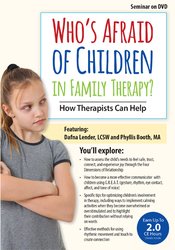

Unlike teens, young children can’t readily talk about feelings, don’t sit in one place, and often can’t follow rules and directions, even when you’re playing a game. So how can you incorporate these crucial family members into your sessions in a way that’s both manageable and productive? This workshop will demonstrate how to apply the principles of Theraplay, a model based on affective neuroscience and attachment theory, to increase a sense of caring and trust between family members.
| File type | File name | Number of pages | |
|---|---|---|---|
| Handouts (0.44 MB) | 9 Pages | Available after Purchase |

Dafna Lender, LCSW, is an international trainer and supervisor for practitioners who work with children and families. She is a certified trainer and supervisor/consultant in both Theraplay and Dyadic Developmental Psychotherapy (DDP) and an EMDR therapist. Dafna’s expertise is drawn from 25 years of working with families with attachment in many settings: at-risk after school programs, therapeutic foster care, in-home crisis stabilization, residential care and private practice. Dafna’s style, whether as a therapist or teacher, is combining the light-hearted with the profound by bringing a playful, intense and passionate presence to every encounter. Dafna is the author of Integrative Attachment Family Therapy (2023) and co-author of Theraplay® - The Practitioner’s Guide (2020).
Speaker Disclosures:
Financial: Dafna Lender maintains a private practice. She is a published author and receives royalties. She receives a speaking honorarium and recording royalties from PESI, Inc. She has no relevant financial relationships with ineligible organizations.
Non-financial: Dafna Lender is an author for Psychotherapy Networker.
Phyllis Booth, Clinical Director Emerita of The Theraplay Institute in Chicago. Along with Ann Jernberg , she created the Theraplay method for helping children and families with attachment and relationship problems. Primary author 3rd edition of Theraplay: Helping Parents and Children Build Better Relationships Through Attachment-Based Play (Jossey-Bass, 2010).
Speaker Disclosure:
Financial: Phyllis Booth is the Clinical Director Emerita of the Theraplay Institute. She is an author for Jossey-Bass and receives royalties. She has no relevant financial relationships with ineligible organizations.
Non-financial: Phyllis Booth has no relevant non-financial relationship to disclose.
Please wait ...